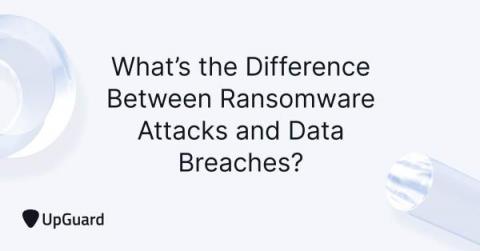Security | Threat Detection | Cyberattacks | DevSecOps | Compliance
April 2022
How We Empower Your Post-Breach Actions
The Cyber Security Breaches Survey 2022: key insights
Navigating the Five Stages of Grief During a Breach
Every security professional dreads “The Phone Call.” The one at 2 a.m. where the tired voice of a security analyst on the other end of the line shares information that is soon drowned out by your heart thumping in your ears. Your mind races. There are so many things to do, so many people to contact. You jump out of bed. For a moment, you stare into the mirror longing for yesterday — when your network hadn’t been breached.
Ransomware Attacks Vs. Data Breaches: What's the Difference?
Ransomware attacks and data breaches seem to be continuously contending for the top positions in news feeds. But what's the difference between these cyber threats and which should you be most concerned about? For a comprehensive breakdown of each type of cyberattack, read on.
What We Can Learn From SolarWinds Security Breach
What is data fabric and how does it impact Cybersecurity?
Amidst sweeping digital transformation across the globe, numerous organizations have been seeking a better way to manage data. Still in the beginning stages of adoption, data fabric provides many possibilities as an integrated layer that unifies data from across endpoints. A combination of factors has created a digital environment where data is stored in several places at once, leaving cracks in security for fraudsters to take advantage of.
3 Critical Lessons & Takeaways from the Okta Data Breach
Last month’s revelation that Okta had been hacked created a seismic impact in the world of security, with organizations still bracing themselves for the fallout from this incident. While resources, like Microsoft’s article on Lapsus$ (tracked as DEV-0537), have broadly dissected the attack vectors used in the group’s attacks, we wanted to expand on the broader trends and context surrounding the Okta hack.
The Top 5 Security Breaches of 2021
Has your business experienced one of the Top 5 Security Breaches of 2021? Sadly, many have. As businesses become more reliant on technology, the risk of becoming a victim of a data breach only increases. Unfortunately, the United States exceeded the previous record of cyber attacks in a single year. In 2017, we saw a whopping 1,529 data breaches – compared to the 1,862 data breaches we saw last year.
Runtime Protection: The Secret Weapon for Stopping Breaches in the Cloud
Mistakes are easy to make, but in the world of cloud computing, they aren’t always easy to find and remediate without help. Cloud misconfigurations are frequently cited as the most common causes of breaches in the cloud. According to a 2021 survey from VMware and the Cloud Security Alliance, one in six surveyed companies experienced a public cloud security breach or incident due to a cloud misconfiguration in the previous 12 months.











